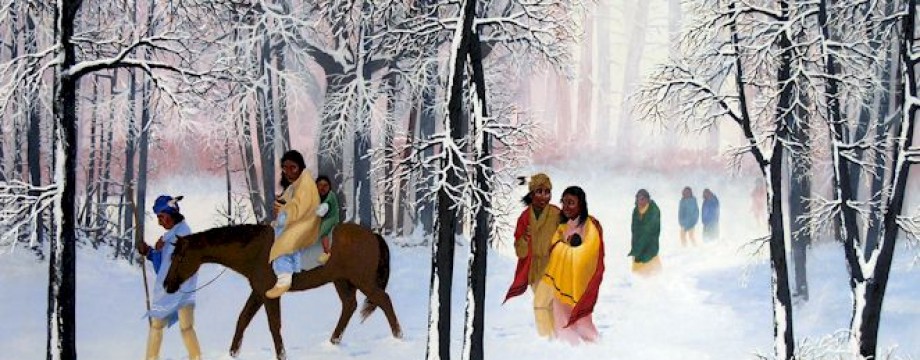People’s knowledge of the Cherokee may not extend beyond Paul Revere and the Raiders. While the sentiment behind the song may be sincere, it is not officially affiliated with the Cherokee. Other people might know about the Trail of Tears, but not know the full story. Here in Northwest Arkansas, several historical markers detail where the Trail of Tears moved through the area. However, it is doubtful any of us can comprehend the devastation brought on by the Indian Removal Act of 1830. Cherokee history is rich and detailed. Thankfully, it continues into today.
The name ‘Cherokee’ itself remains largely a mystery as its origins are unknown. It could be a mispronunciation of what other Native American tribes referred to the Cherokee. However, Cherokees refer to themselves as Tsalagi (ᏣᎳᎩ) or Aniyvwiyaʔi (ᎠᏂᏴᏫᏯᎢ), which means “Principal People.”
All Cherokee once lived in the Southern Appalachians. In the eighteenth century, they claimed hunting grounds that extended into Kentucky, but they clustered their villages and agricultural fields in the valleys of upcountry South Carolina, western North Carolina, east Tennessee, north Georgia, and northeastern Alabama. They spoke four mutually intelligible dialects of an Iroquoian language. A common culture and bonds of kinship held their far-flung villages together and made them a people. Today, most Cherokees do not live in the Southeast; they live in eastern Oklahoma with only a small remnant remaining in the mountains of western North Carolina. The United States recognizes three tribes – the Cherokee Nation and United Keetoowah Band in Oklahoma and the Eastern Band of Cherokees in North Carolina. The division of Cherokees was not by choice. In the early nineteenth century, the United States forced the Cherokee Nation to surrender its homeland and relocate west of the Mississippi. That event is known as the Trail of Tears.(Perdue and Green xiii)
This section from the introduction of The Cherokee Nation and the Trail of Tears best summarizes the historical and modern locality of the Cherokee. Cherokee legend describes how the Cherokees were given their land by the Great Spirit. The West is symbolic of the color black and death for the Cherokee. So, “abandoning their homeland at the world’s center, and moving west, the direction associated with death, was unthinkable” (Perdue and Green 6). The Cherokee looked to the landscape around them in the Southeast and were reminded of folktales that detailed their past and life lessons that told them how to live everyday.
Cherokees had seven clans […] that traced their ancestry back to a common, mythical ancestor. [They] were scattered throughout Cherokee villages, which reportedly numbered sixty-four in the mid-eighteenth century, and served to unite Cherokees. Until the late 1700s, Cherokees did not seem to have a centralized government. Clans provided protection […] and corporate decisions were made at the clan or lower level. This political decentralization, however, does not mean the Cherokees did not think of themselves as a people – they did – but that identity rested on the ties of kinship, language, and shared beliefs, all of which connected them to their homeland. (Perdue and Green 10).
Cherokee names for places marked the territory as their own and told of kinship ties. “The Cherokees inscribed their identity on the landscape” (Perdue and Green 10). Clearly, the Cherokee land was an organic jurisdiction that bespoke of their shared cultural history, which only those privy to the tribe would understand. The mountains physically separated them from other tribes, but so did the Cherokee creation tales of the mountain. This story about the land and for the land describes the distinction between organic and synthetic jurisdiction. Lines on a map and demarcated space is synthetic; it tells no complicated tales to define its existence. A history is breathed into organic jurisdiction as the people who inhabit the land detail how the land and their connection to it came to be. This tie to land is why looking at the Cherokee’s forced removal remains important. The Southeast is not the Midwest. No true mountains exist in Oklahoma, only flat lands and wide skies. The Cherokee were not a Plains tribe, but their forced removal required a change in identity. Since the early to mid 1800s, the Cherokee remain scattered and continue to deal with their fragmented identity.
The Trail of Tears, as Principal Chief Hicks of the Eastern Band of Cherokee Indians said in 2005, plays a “central role […] in the identity of Cherokees today” (Perdue and Green 164). Furthermore, Principal Chief Chad Smith of the Cherokee Nation says that “We [him and his tribe] are not a people of the past. We are a people of the present, and for many centuries, we will be a people of the future” (Perdue and Green 164). Despite their uprooting and subsequent trials, the Cherokee are not a destroyed people. Rather, they continue to thrive as a shared past, culture and language tie them together, just as it did when they lived in villages across the Southeast. As of 2007, “there are 240,000 citizens of the Cherokee Nation and 10,000 members of the United Keetoowah Band […] and 13,500 enrolled members of the Eastern Band in North Carolina” (Perdue and Green 164). That totals approximately 263,500 recognized Cherokee citizens, not including the thousands of other Americans who have Cherokee ancestry.

Map of US South. It shows the land holdings of the Cherokee before relocation(dark green) and afterwards (yellow). Also note the other Native American tribes forced from their traditional homelands to live in the Midwest. It was not only the Cherokee who were uprooted and moved beyond the Mississippi.
